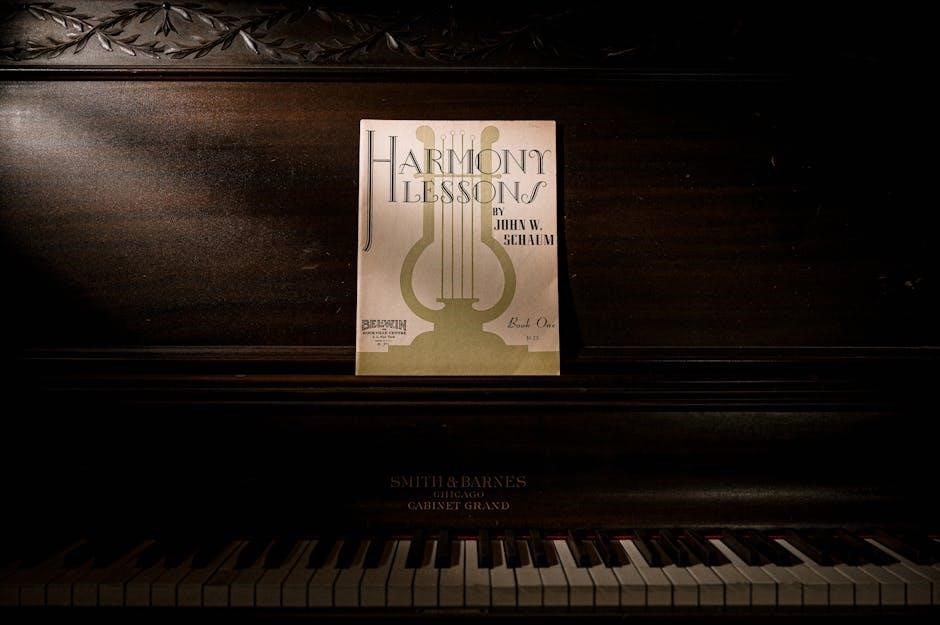The “Goodness of God” sheet music is a popular choice for worship, offering piano, guitar, and vocal arrangements․ Its accessible composition makes it ideal for congregational singing and personal devotion, celebrating God’s faithfulness and mercy with emotional depth and simplicity․
1․1․ Overview of the Song and Its Popularity
“Goodness of God” has become a beloved worship anthem, resonating globally for its heartfelt lyrics and uplifting melody․ Its popularity stems from its emotional depth, celebrating God’s faithfulness and mercy․ Available in various formats, including PDF, the sheet music accommodates pianists, guitarists, and vocalists․ The song’s simplicity and powerful message make it a favorite in worship settings, appealing to diverse denominations and musical styles․ Its widespread use in churches and personal devotion underscores its enduring impact on Christian music․
1․2․ Importance of Sheet Music in Worship and Performance
Sheet music for “Goodness of God” is essential for worship leaders and musicians, providing a structured framework for performances; It ensures consistency in melody, harmony, and lyrics, fostering unity in congregational singing․ The availability of piano, guitar, and vocal scores makes it accessible for various ensembles․ Sheet music also serves as a valuable resource for personal practice, enabling musicians to refine their craft․ Its clarity and organization enhance the worship experience, allowing for a deeper connection with the song’s inspirational message․

Background of the Song “Goodness of God”
The song “Goodness of God” was created by Jenn Johnson, Ed Cash, Jason Ingram, Ben Fielding, and Brian Johnson, popularized by Bethel Music and CeCe Winans․ It has become a powerful anthem celebrating God’s faithfulness and mercy, resonating deeply in Christian worship worldwide․
2․1․ Songwriters and Original Recording Artists
“Goodness of God” was written by Jenn Johnson, Ed Cash, Jason Ingram, Ben Fielding, and Brian Johnson․ The song gained widespread recognition through Bethel Music and has been notably performed by CeCe Winans․ Its powerful lyrics and melody have made it a beloved anthem in Christian worship, with the original recording showcasing heartfelt delivery and spiritual depth․ The song’s creation and performance reflect a collaborative effort to glorify God’s faithfulness․ CCLI Song #7117726․
2․2․ Theological Themes and Inspirational Message
The song emphasizes God’s unwavering mercy and faithfulness, reflecting a deep theological foundation․ It inspires listeners to trust in God’s goodness, celebrating His presence throughout life’s journey․ The lyrics highlight personal experiences of divine faithfulness, fostering gratitude and hope․ This message resonates universally, encouraging believers to rely on God’s love and provision․ The song’s themes of trust and redemption make it a powerful tool for spiritual reflection and worship․ Its inspirational message transcends individual circumstances, pointing to God’s enduring goodness․ CCLI Song #7117726․
2․3․ The Song’s Impact on Christian Music and Worship
“Goodness of God” has profoundly influenced Christian music, becoming a staple in worship services worldwide․ Its emotional depth and uplifting message resonate across denominations, making it a favorite for congregational singing․ The song’s widespread adoption in churches underscores its ability to connect believers, fostering unity and spiritual reflection․ Its popularity has also led to numerous covers and adaptations, further cementing its place in contemporary Christian worship․ The sheet music’s accessibility has enabled its use in various settings, from intimate devotion to large gatherings, solidifying its impact on modern worship culture․

Sheet Music Structure and Composition
The sheet music features a simple, worship-friendly structure in the key of G, with a moderate tempo․ It includes verses, a chorus, and instrumental arrangements, emphasizing God’s faithfulness․
3․1․ Musical Key and Tempo Recommendations
The sheet music for “Goodness of God” is commonly arranged in the key of G, offering a comfortable range for both vocalists and instrumentalists․ A moderate tempo is suggested, typically around 96 BPM, to maintain a worshipful and reflective feel․ This key and tempo combination creates a balanced sound, suitable for congregational singing and instrumental accompaniment․ The structure supports emotional expression while remaining accessible for musicians of various skill levels, ensuring a harmonious and engaging worship experience․
3․2․ Chord Progressions and Harmonies
The sheet music features a chord progression that begins with G and C, transitioning to D/F and Em, creating a dynamic yet worshipful sound․ These chords support the song’s emotional depth, from intimate reflection to joyful celebration․ Harmonies are rich and layered, with options for pianists and guitarists to add suspended chords or minor progressions, enhancing the melody’s resonance․ This structure ensures versatility for both solo and group performances, catering to various musical styles while maintaining the song’s heartfelt essence․
3․3․ Vocal and Instrumental Arrangements
The sheet music offers versatile arrangements, including piano, guitar, and vocal scores․ It supports piano solos, acoustic guitar strumming, and full band setups․ Vocal parts range from simple melodies to harmonized choruses, suitable for both soloists and choirs․ Instrumental breaks and interludes add depth, while optional orchestral elements like strings and woodwinds can elevate performances․ These arrangements ensure the song can be adapted to various settings, from intimate worship to large congregational gatherings, maintaining its powerful emotional impact and theological depth․

Lyrics and Their Biblical Significance
The song’s lyrics praise God’s faithfulness and mercy, reflecting on His presence throughout life․ Biblical themes of gratitude and trust shine through, resonating deeply with worshippers․
4․1․ Breakdown of Verse 1 and Its Meaning
Verse 1 begins with a heartfelt declaration: “I love you, Lord, for your mercy never fails me․” This line emphasizes God’s unwavering love and faithfulness; The lyrics reflect a personal testimony of experiencing God’s goodness, drawing from biblical themes of divine faithfulness․ The verse invites worshippers to reflect on their own journeys, acknowledging God’s consistent presence and mercy․ Its simple yet profound language creates a relatable and intimate connection, setting the tone for the song’s celebration of God’s character․
4․2․ The Chorus: A Celebration of God’s Goodness
The chorus of “Goodness of God” is a powerful expression of praise, declaring, “Your goodness is going to follow me every day of my life․” This uplifting refrain highlights God’s faithfulness and enduring love․ The repetition of “goodness” emphasizes its central theme, while the melody elevates the emotional impact․ The chorus invites worshippers to join in celebration, creating a unifying moment of communal praise․ Its simplicity and memorable structure make it a favorite for congregational singing, deeply resonating with believers․
4․3․ Verse 2 and the Expression of Gratitude
Verse 2 of “Goodness of God” deepens the emotional connection, reflecting on life’s seasons and God’s sovereignty․ The lyrics express gratitude for His presence in both joy and hardship, emphasizing trust and devotion․ The melody supports the heartfelt words, creating a intimate worship experience․ This verse encourages believers to acknowledge God’s faithfulness, fostering a spirit of thanksgiving․ Its personal yet universal message resonates deeply, making it a powerful tool for personal reflection or communal praise, celebrating God’s enduring love and provision․

Sheet Music Availability and Formats
The sheet music for “Goodness of God” is widely available in various formats, including piano, guitar, and vocal scores, as well as digital and PDF versions, ensuring accessibility for all musicians․
5․1․ Piano, Guitar, and Vocal Scores
Piano, guitar, and vocal scores for “Goodness of God” are readily available, offering versatile arrangements for worship․ The piano score is often in the key of G, featuring a flowing melody that complements the song’s emotional depth․ Guitar scores include chord progressions like G, C, and D, making it accessible for both acoustic and electric players․ Vocal arrangements are typically written for SATB, allowing for harmonious group performances․ These scores are designed to enhance both congregational and personal worship experiences, ensuring clarity and ease for musicians of all skill levels․
5․2․ Orchestral and Band Arrangements
Orchestral and band arrangements of “Goodness of God” offer expansive instrumentation to enrich worship․ Scores often include strings, woodwinds, brass, and percussion, creating a grand yet emotive sound․ These arrangements typically feature the song in the key of G, aligning with the original composition․ Lead sheets and SATB vocal parts are frequently included, allowing for seamless integration of choirs and congregational singing․ Such arrangements are ideal for larger worship settings, enhancing the song’s emotional impact while maintaining its heartfelt message of gratitude and devotion․
5․3․ Digital and PDF Versions for Easy Access
Digital and PDF versions of “Goodness of God” sheet music are widely available, offering convenience for musicians; Platforms like Musicnotes and PraiseCharts provide downloadable PDFs, ensuring easy access to piano, vocal, and instrumental scores․ These formats allow for instant printing or digital viewing, making them ideal for last-minute preparations or spontaneous worship․ Many versions are transposable, enabling customization to suit various vocal ranges or instrumental needs․ This accessibility ensures the song’s message of God’s goodness can be shared effortlessly across different worship settings and communities․

Resources for Downloading the Sheet Music
Download “Goodness of God” sheet music from trusted platforms like Musicnotes and PraiseCharts․ These sites offer PDF and MIDI files for piano, guitar, and vocals, ensuring easy access for worship preparation and performance․
6․1․ Official Websites and Licensed Distributors
For authentic “Goodness of God” sheet music, visit official sites like Bethel Music, Musicnotes, and PraiseCharts․ These platforms provide licensed PDFs, ensuring quality and legality․ They offer various arrangements, including piano, guitar, and vocal scores, making them ideal for worship leaders and musicians․ Purchasing from these sources supports the artists and guarantees accurate compositions․ Always choose licensed distributors to avoid copyright issues and ensure a seamless worship experience․
6․2․ Free and Paid Platforms for PDF Downloads
Various platforms offer “Goodness of God” sheet music in PDF format․ Websites like Musicnotes and PraiseCharts provide both free and paid options, with paid versions often offering more detailed arrangements․ Free platforms may include basic scores, while premium sites deliver high-quality, licensed sheet music․ Additionally, online communities and forums share user-generated PDFs, though quality and accuracy may vary․ Always verify licensing to ensure compliance with copyright laws and support the creators․
6․3․ Tips for Finding High-Quality Sheet Music
To find high-quality “Goodness of God” sheet music, prioritize official sources like Musicnotes or PraiseCharts․ Ensure the PDF is licensed and matches your instrument or vocal range․ Read reviews and previews to confirm accuracy․ Look for updates or new arrangements for freshness․ Verify compatibility with your software or device for seamless use․ Supporting creators by purchasing directly or through official platforms ensures quality and legality․ Always check for copyright compliance to avoid unauthorized versions․

Learning and Playing “Goodness of God”
Learning “Goodness of God” involves mastering its structure, including verses, chorus, and bridge․ The song is typically in the key of G with a moderate tempo, making it accessible for most musicians․
Begin by practicing each section slowly, focusing on chord transitions and vocal harmonies․ Gradually increase tempo to build confidence and fluency in performance․
Utilize online tutorials and guides to refine your technique․ These resources often provide chord charts, melodies, and performance tips tailored to your instrument or vocal range․
7․1․ Tutorials and Guides for Musicians
Tutorials and guides for “Goodness of God” are widely available, offering step-by-step instruction for piano, guitar, and vocal arrangements․ These resources often include chord charts, sheet music, and performance tips, helping musicians of all skill levels to master the song․ Many guides focus on leading worship, providing insights into dynamics, tempo, and emotional expression․ Additionally, video tutorials and practice tracks can aid in refining instrumentation and harmonies․ Proper licensing and attribution are emphasized to ensure legal performance and credit to the songwriters․ Online communities and forums also share user-generated guides, fostering collaboration and shared learning among musicians․
7․2․ Practice Tips for Vocalists and Instrumentalists
Vocalists should focus on connecting with the song’s emotional depth, practicing breath control and diction․ Instrumentalists can refine chord progressions and melodies, ensuring harmonies align with the sheet music․ Start with slower tempos and gradually increase speed․ Dynamics and expression are key for conveying the song’s message․ Regular practice with metronomes or backing tracks can enhance timing and consistency․ Collaborative rehearsals with other musicians help build unity and balance in performance․
7․3․ Leading Worship with “Goodness of God”
Leading worship with “Goodness of God” begins with creating a heartfelt atmosphere, emphasizing the song’s emotional depth․ Start with a slow, introspective intro to draw the congregation in․ Gradually build energy through the chorus, encouraging participation․ Use dynamics and expression to highlight the theological themes of God’s faithfulness and mercy․ Encourage personal reflection during verses and celebrate collectively in the chorus․ Balance instrumentation and vocals to maintain focus on the song’s message, fostering unity and spiritual connection among worshipers․

The Role of “Goodness of God” in Worship Services
“Goodness of God” serves as a powerful tool in worship, creating a spiritual atmosphere of gratitude and reflection․ Its heartfelt lyrics and melody inspire congregational unity, fostering a deeper connection with God’s faithfulness and mercy, making it a beloved choice for worship leaders and believers alike in celebrating divine goodness․
8․1․ Using the Song in Congregational Worship
“Goodness of God” is widely used in congregational worship for its uplifting and unifying message․ The song’s simple yet powerful melody, combined with its heartfelt lyrics, creates an atmosphere of gratitude and reflection․ Its structure, featuring call-and-response verses and a memorable chorus, makes it easy for congregations to engage and participate․ The theological richness of the song, emphasizing God’s faithfulness and mercy, resonates deeply with worshippers, fostering a sense of unity and collective praise․
8․2․ Incorporating the Song into Personal Devotion
“Goodness of God” is a powerful tool for personal devotion, offering a deeply intimate and reflective worship experience․ The song’s simple, heartfelt lyrics and accessible melody make it easy to incorporate into private prayer or meditation․ Its repetitive structure emphasizes themes of mercy, faithfulness, and divine goodness, fostering a personal connection with God․ Many find solace in playing the song on piano or guitar during quiet moments, using it as a means to express gratitude and deepen their spiritual practice․
8․3․ The Song’s Universal Appeal Across Denominations
“Goodness of God” resonates across diverse Christian denominations due to its timeless themes of God’s mercy and faithfulness․ The simplicity and emotional depth of the lyrics transcend specific doctrines, making it accessible to a broad audience․ Its widespread use in various worship settings highlights its universal appeal, as churches worldwide adopt it for congregational singing and personal devotion; This unity in worship underscores the song’s ability to connect believers across different traditions and cultural backgrounds, fostering a shared experience of praising God’s goodness․

Legal and Copyright Considerations
Using “Goodness of God” sheet music requires proper licensing and adherence to copyright laws․ Ensure legal performance rights and provide attribution to the songwriters and publishers․
9․1․ Licensing Requirements for Performance
Performing “Goodness of God” requires obtaining proper licensing, such as a CCLI license, to ensure legal compliance․ This license (CCLI Song #7117726) covers public performances and worship services․ Proper licensing ensures fairness to the songwriters and publishers, supporting their work․ Always verify licensing requirements in your region to avoid copyright infringement․ This step is crucial for churches, worship teams, and musicians using the song in public settings․ Licensing also varies based on the size and type of event or venue․
9․2․ Copyright Laws and Fair Use Guidelines
Using “Goodness of God” sheet music requires adherence to copyright laws․ The song, copyrighted by Bethel Music, is protected under intellectual property rights․ Fair use permits non-commercial, educational, or personal use, but public performance or distribution may require licensing․ Proper attribution to the songwriters and publishers is essential․ Always ensure compliance with copyright laws to respect the creators’ rights and avoid legal issues․ This ensures ethical use of the music for worship or personal enjoyment․
9․3․ Proper Attribution and Credit for Creators
Proper attribution is crucial when using “Goodness of God” sheet music․ Always include the copyright notice, listing songwriters Jenn Johnson, Ed Cash, Jason Ingram, Ben Fielding, and Brian Johnson, along with the publisher, Bethel Music․ Mentioning the CCLI Song #7117726 is also required․ This ensures compliance with licensing agreements and gives due credit to the creators․ Proper attribution respects intellectual property rights and supports the continued creation of worship music for the church․ It is a vital part of ethical music use․

Community and Sharing
Sharing “Goodness of God” sheet music fosters community among musicians, enabling collaborative performances and worship events․ Online platforms and forums provide spaces for musicians to exchange resources and ideas, promoting unity and creativity in worship music․
10․1․ Sharing Sheet Music with Fellow Musicians
Sharing “Goodness of God” sheet music with fellow musicians fosters collaboration and inspiration․ Digital formats like PDFs make it easy to distribute and access, ensuring everyone can participate․ Musicians can exchange arrangements, learn from each other, and create unified worship experiences․ Sharing resources strengthens musical communities, encouraging creativity and teamwork․ It also allows for the preservation and wider dissemination of meaningful worship music, benefiting individuals and groups alike in their spiritual and musical journeys․
10․2․ Collaborative Performances and Worship Events
Collaborative performances of “Goodness of God” bring musicians and worshippers together, creating powerful expressions of faith․ The sheet music’s versatility allows vocalists and instrumentalists to unite, enhancing the emotional impact of the song․ Worship events benefit from the shared experience, fostering a sense of community and spiritual connection․ By combining talents, musicians can lead congregations in heartfelt praise, making the song a unifying force in worship settings and personal devotion alike․
10․3․ Online Communities for Music Sharing
Online platforms like MuseScore and PraiseCharts offer “Goodness of God” sheet music, fostering a global community of musicians and worshippers․ These sites allow users to share, download, and review arrangements, promoting collaboration and accessibility․ Musicians can engage in discussions, exchange tips, and inspire one another, while worshippers benefit from diverse interpretations․ Such communities strengthen the song’s reach and impact, ensuring its message of God’s goodness resonates widely across cultures and denominations․
